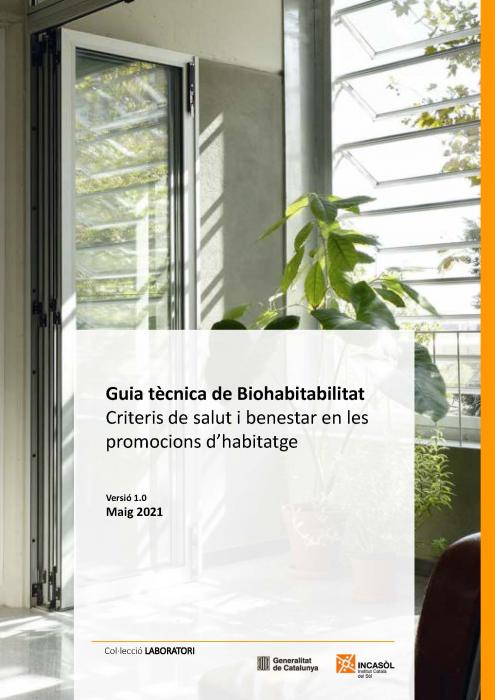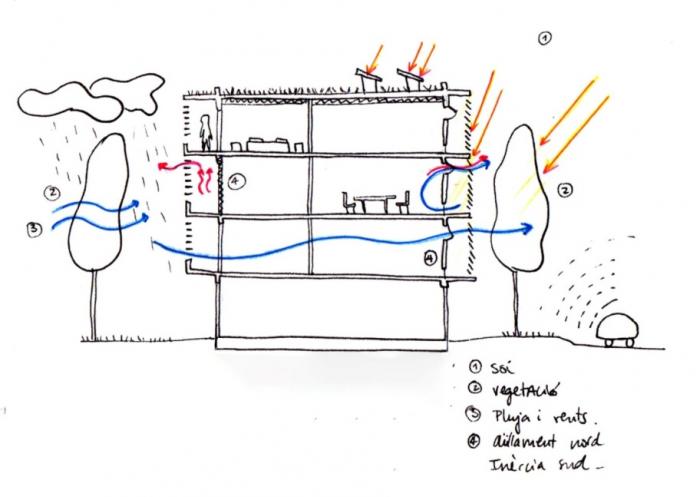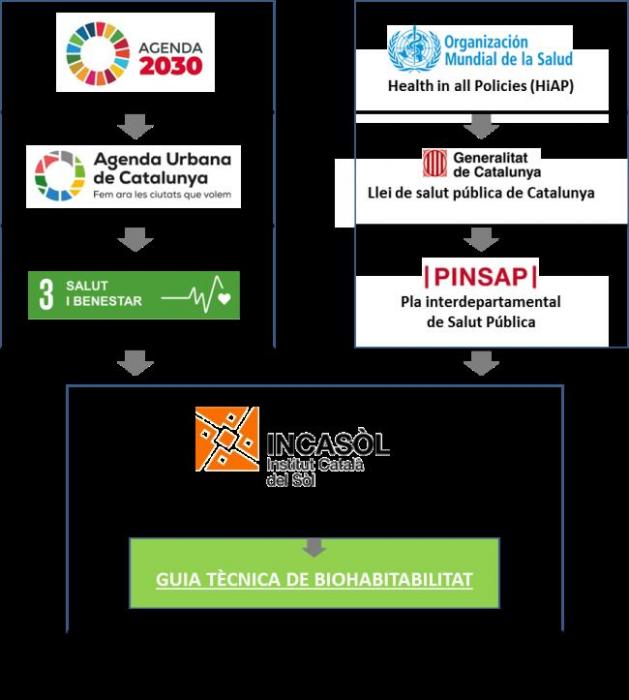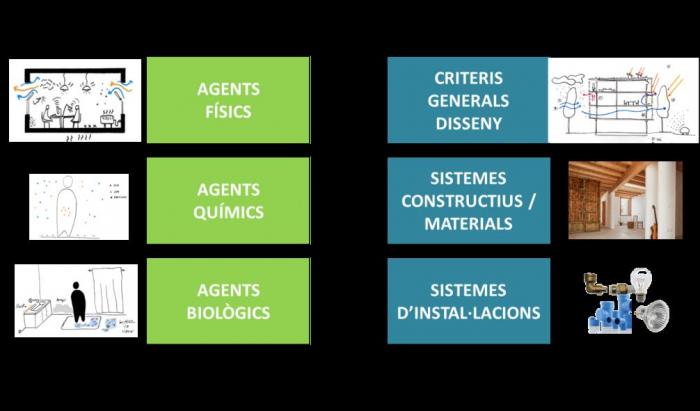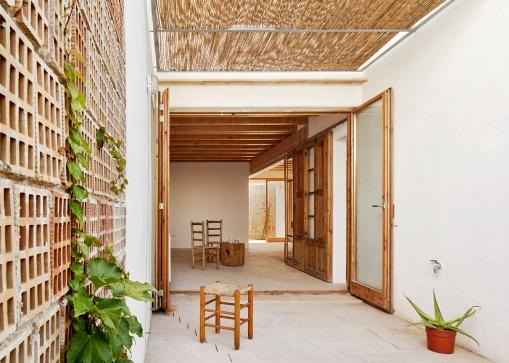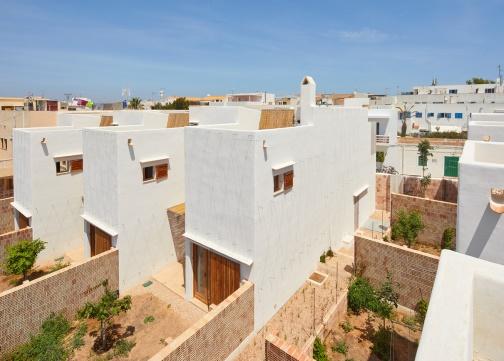I. SUMMARY INFORMATION
Project
268596
Status
Submitted
Award category
Techniques, materials and processes for construction and design
You want to submit
NEW EUROPEAN BAUHAUS AWARDS : existing completed examples
Project title
BioHabitability technical guide
Full project title
BioHabitability technical guide_Health and well-being criteria for housing and offices constructions
Description
Traditional architecture was centred only in the technical and aesthetic needs of the constructions, independently of the effect on their final users.This guide has been developed including, well-being, health and environmental sustainability criteria and inclusivity aspects which set solutions demanded by the society and aligned with the engagement on Climate Action and the principles of the Urban Agenda.
Where was your project implemented in the EU?
Spain
Catalonia
C/Córsega 273
Barcelona
08008
When was your project implemented?
Has your project benefited from EU programmes or funds?
No
Which programme(s) or fund(s)? Provide the name of the programme(s)/fund(s), the strand/action line as relevant and the year.
II. DESCRIPTION OF THE PROJECT
Please provide a summary of your project
From the Paris Agreements and the 17 Development Goals our intervention model has progressed under environmental sustainability and boosting inclusivity criteria which are solutions requested by the society and are aligned with the agreements on Climate Action and Urban Agenda. We need to progress into a more inclusive society in which the right to the city combines perfectly well with other basic rights of the people as housing, education and health. Thus, in the latest years l’INCASÒL bet for incorporating to their knowledge and its production elements, innovations and proposals that back up those new requirements, focusing on health related building issues.
Following this will, we created the Technical Guide on Biohabitability (Guia Tècnica de Biohabitabilitat in Catalan). This guide includes a complete and detailed study on factors affecting users’ health, from materials to technical solutions and environmental aspects. The guide is based on our experiences and main studies and references on how to attain best practices on healthy housing solutions. It is designed considering European Union international standards, so it can be easily transferred to many other locations.
Our will is to have a clear and useful tool to rethink and solve any health issue and concerns which could be present on housing and city development.
Please give information about the key objectives of your project in terms of sustainability and how these have been met
We reduced the environmental impact of the cities through a more efficient and sustainable housing design. The guide determines the measures to implement to increase the energy efficiency– both at new housing building and on refurbishing – considering its effect on health as temperature comfort and at social level (If energy is cheaper, more people can pay the energy to reach comfort temperature).
We guarantee a healthy environment in which live in free from contamination on inner air. More and more faults are detected on inner ambience quality in aspects that are beyond temperature in buildings that can be highly efficient in energy, built with systems highly technical and hermetic. It is understandable the need to reduce emissions to obtain environmental friendly buildings, more sustainable, passive and with renewable energy sources. But these aspects do not automatically imply obtaining an optimal quality on inner ambience or a good comfort level. It is obvious that buildings need to be efficient and reduce their emissions, but we need to remember that they are meant to be designed to have positive effects on the comfort and health of their users, and so, they need to guarantee some aspects, such a correct oxygenation, resting areas free form factors that affect resting, acclimatization systems preventing moving air so the dust remains set, air free from bioaerosols, etc.
The recommendations set different levels: general and design criteria (bioclimatism), material selection criteria and building systems (isolation, coatings, wood works, paints, etc.), recommendations on supply systems (power, acclimatization, supplies, water,...). To keep an optimal habitability during the full lifetime of the building some guidelines on final user usage and maintenance: recommendations on house cleaning products, guidelines on aeration, efficient use of passive measures on climate control (shades, green houses, balconies, etc.)
Please give information about the key objectives of your project in terms of aesthetics and quality of experience beyond functionality and how these have been met
The guide opts for the integrated design, offering a panoramic vision of all the elements participating on reaching health and wellbeing criteria. Facilitating the integration of passive resources (spaces design, materials quality, heat control systems,...) as well as the active ones (acclimatization systems,...), thus the aesthetic quality and experience of the projected housing units.
One of the main aims of the guide is setting recommendations on quality experience of the housing spaces. Health and wellbeing criteria are fully aligned and have a direct relation to the sensations and perceptions of the spaces. The guidelines and recommendations, technical materials characteristics and usage guidelines stablish ambiences of high interior quality.
To attain this aims the guide selects examples for their singular traits which can be reference and inspiration models as the Ricola industrial building (Swizerland) or public housing model at Life Reusing Poseidonia (Illes Balears).
Please give information about the key objectives of your project in terms of inclusion and how these have been met
The main aim of the guide is ensure that citizens have access to a decent, accessible, environmentally sustainable housing, with quality and fostering health and wellbeing, especially for people particularly vulnerable or at risk.
The guide has been defined with an structure and content directed to reach this main aim. It is a complete Biohabitability guide with building criteria on design, materials and installations as well as maintenance and user guidelines.
Applying the directives on this guide benefit the collectives prone to vulnerability as the they promote preventive health, reducing risk factors and the exposure to them; minimize power poverty through design, materials, and usage guidelines. It also boosts the empowerment of people allowing them to know and understand its usage with the information provided.
Please give information on the results/impacts achieved by your project in relation to the category you apply for
Health issues related to building procedures are easy to overcome in design and building if we are able to recognise the issues, know how are thei produced and filally how to overcome them before starting the building design. Once the issues arise on a building it is very difficult to overcome them, both at a technical and costs aspect. So, it is important to know the aspect that participate o0n the health of the buildings and include them from the very beginning.
This guide is applied on the present and future affordable for rent housing developments by Incasol. The main innovation is adding the health factor on them. Thus, it turns into a change motor, which results can have impact on other public bodies and private sector.
If we consider the guide as a methodology it can also have a great impact on other knowledge areas, as we are already considered writing a similar guide on land development and planning.
So, from this integral, shared vision we contribute to reach the aims of the different global agendas and so, have a big impact on the wellbeing of the society: Agenda 2030, Urban Agenda, Health in All Policies and Planetary Wellbeing.
Please explain the way citizens benefiting from or affected by the project and civil society have been involved in the project and what has been the impact of this involvement on the project
The guide set human beings as the references for planning, designing, and building of the housing spaces, with a commitment on social aspects and Planetary Wellbeing.
The guide summarizes building criteria and biohabitability indicators requested by the society. So, even if there is not a direct participation of the users on guide, we can determine that there is an indirect participation as the requirements of the citizens are the base of the guide.
The guide has an active role in booting decision making for the citizens and for the citizens to establish tools and processes for co-participation.
Please highlight the innovative character of the project
Health is no longer an aspect exclusive of health industry to turn into a real transversal vector in all industries and in all knowledge areas. As land planning processes have not been designed from this point of view.
The guide wants to set higher habitability criteria than the ones stablished at the present. The experience shows that guidelines and practices are not enough to prevent some issues on habitability. Sick building syndrome is a clear example of this issue and it is addressed on the guide through preventive actions.
Technical references on the guide come from diverse areas as health care, biology and architecture. Implementing it shows the need to consolidate the technical consultancy on biohabitability as an added agent on project design.
Incasòl is currently drafting the executive project for the refurbishment of the corporative offices and, as a pilot test, is incorporating the technical consultancy on biohabitability into the drafting team.
Please explain how the project led to results or learnings which could be transferred to other interested parties
A key aspect of the guide is to promote information and guidelines transference. So it has been written with a complete and rigorous content, a clear structure, a visual and easy to use design, able to be used in different communications channels, online or live, in hard or digital copies. The suggestions and guidelines refer to international standards in terms of health and legal directives. And the results can be easily used in diverse areas.
Is an evaluation report or any relevant independent evaluation source available?
III. UPLOAD PICTURES
IV. VALIDATION
By ticking this box, you declare that all the information provided in this form is factually correct, that the proposed project has not been proposed for the Awards more than once under the same category and that it has not been subject to any type of investigation, which could lead to a financial correction because of irregularities or fraud.
Yes
